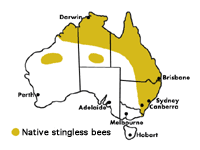Native Bees
There are over 2000 species of native bees, although only about 1700 have been named! The smallest is Cape York’s 2mm long Quasihesma bee, and the largest is the carpenter bee found in Queensland and northern New South Wales which can grow to 24mm long. It is thought that native bees are more efficient pollinators of many Australian native plant species than introduced honey bees (Apis mellifera).
Solitary bees
The majority of our native bees are solitary. They are capable of stinging, although the stings are relatively mild and the bees are not aggressive. Solitary bees do not store honey in their nests, and only collect tiny amounts of nectar to feed their young. A typical example is the mortar or blue banded bee which feeds on nectar and pollen, and can sometimes be found nesting in mortar between bricks or in mud bricks. It is a powerful tunneller and can remove most of the mortar around bricks in older homes. In the wild it burrows into compacted earth or even into solid sandstone rock.
Social bees
There are only 10 species of social native bees (Trigona and Austroplebeia spp.), which live in hives, make honey and are stingless. These tiny black bees (about 4mm long) usually nest in tree hollows or old logs, and colonies can include many thousands of workers. Aborigines traditionally harvested Trigona nests for their strongly flavoured, sweet honey. Apparently they used to catch a bee and tie a white feather to its leg with a hair, and then follow the white feather as the bee went back to the hive.
Keeping native bees
Stingless native bee species only produce small amounts of honey, so it is important not to harvest honey from wild hives. However, stingless bees can make great pets. They are small, quiet, interesting to watch and easy to look after. Although it is illegal to take native bee nests from national parks and reserves, it may be possible to remove nests from private land with the permission of the land owner. In some states nests can be purchased from beekeepers who have rescued them from land about to be cleared for development.
Further information
For information about keeping native bees, contact the Australian Native Bee Research Centre (ANBRC), PO Box 74-BB, North Richmond NSW 2754. Fax: (02) 4576 1196. Website: www.zeta.org.au/~anbrc/
Your local bee keeping club or association may also be able to help.
Legal requirements vary regarding the keeping of native bees. For information about regulations in your area, contact your local council or Dept of Primary Industry and Agriculture.
For information on the honey bee industry refer to the The Australian Honeybee Industry Council Homepage www.honeybee.org.au



